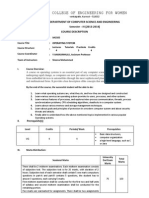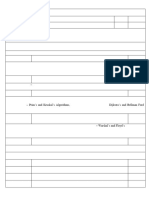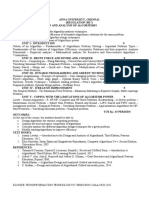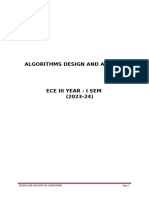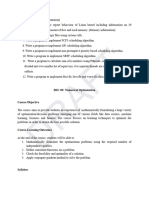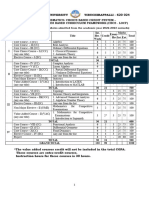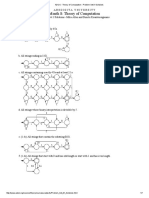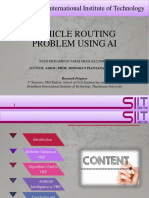22CS303_DAA_Syllabus-new
22CS303_DAA_Syllabus-new
Uploaded by
vimal2k24Copyright:
Available Formats
22CS303_DAA_Syllabus-new
22CS303_DAA_Syllabus-new
Uploaded by
vimal2k24Copyright
Available Formats
Share this document
Did you find this document useful?
Is this content inappropriate?
Copyright:
Available Formats
22CS303_DAA_Syllabus-new
22CS303_DAA_Syllabus-new
Uploaded by
vimal2k24Copyright:
Available Formats
DESIGN AND ANALYSIS OF ALGORITHMS L T P C
22CS303 (Common to CSE, IT and AIML) 2 0 2 3
OBJECTIVES:
The Course will enable learners to:
● Critically analyse the efficiency of alternative algorithmic solutions for the sameproblem
Illustrate brute force and divide and conquer design techniques.
● Explain dynamic programming for solving various problems.
● Apply greedy technique and iterative improvement technique to solve optimization
problems
● Examine the limitations of algorithmic power and handling it in different problems.
UNIT I INTRODUCTION 6+6
Notion of an Algorithm – Fundamentals of Algorithmic Problem Solving –Fundamentals of the
Analysis of Algorithmic Efficiency – Asymptotic Notations and their properties. Analysis
Framework –Mathematical analysis for Recursive and Non-recursive algorithms
List of Exercise/Experiments:
1. Perform the recursive algorithm analysis.
2. Perform the non-recursive algorithm analysis.
UNIT II BRUTE FORCE ANDDIVIDE AND CONQUER 6+6
Brute Force - String Matching - Exhaustive Search - Knapsack Problem -Divide and Conquer
Methodology – Binary Search – Merge sort – Quick sort - Multiplication of Large Integers –
Closest-Pair and Convex Hull Problems - Transform and Conquer Method: Heap Sort
List of Exercise/Experiments:
1. Write a program to search an element using binary search
2. Write a program to sort the elements using merge sort and find time complexity.
3. Write a program to sort the elements using quick sort and find time complexity.
4. Write a program to sort the elements using heap sort
UNIT DYNAMIC PROGRAMMING 6+6
III
Dynamic programming – Principle of optimality – Floyd‘s algorithm – Multi stage graph -
Optimal Binary Search Trees - Longest common subsequence - Matrix-chain multiplication –
Travelling Salesperson Problem – Knapsack Problem and Memory functions.
List of Exercise/Experiments:
1. Solve Floyd’s algorithm
2. Write a program to find optimal binary search tree for a given list of keys.
3. Solve the multi-stage graph to find shortest path using backward and forward
approach
4. Write a program to find the longest common subsequence
UNIT GREEDY TECHNIQUE AND ITERATIVE IMPROVEMENT 6+6
IV
Greedy Technique – Prim‘s algorithm and Kruskal’s Algorithm –Huffman Trees. The Maximum-
Flow Problem – Maximum Matching in Bipartite Graphs- The Stable marriage Problem
List of Exercise/Experiments:
1. Write a program to find minimum spanning tree using Prim’s algorithm
2. Implement Kruskal’s algorithm to find minimum spanning tree
3. Write a program to solve maximum flow problem
UNIT V BACKTRACKING AND BRANCH AND BOUND 6+6
P, NP NP- Complete and NP Hard Problems. Backtracking – N-Queen problem - SubsetSum
Problem. Branch and Bound– LIFO Search and FIFO search - Assignment problem
– Knapsack Problem - Approximation Algorithms for NP-Hard Problems – Travelling
Salesman problem
List of Exercise/Experiments:
1. Write a program to implement sum of subset problem.
2. Write a program to solve N-Queen problem
3. Solve the assignment problem using branch and bound technique
4. Solve knapsack problem using branch and bound technique
TOTAL:60PERIODS
OUTCOMES:
Upon completion of the course, the students will be able to:
CO1:Solve mathematically the efficiency of recursive and non-recursive algorithms
CO2: Design and Analyse the efficiency of divide and conquer and transform andconquer
algorithmic techniques
CO3:Implement and analyse the problems using dynamic programming
CO4:Solve the problems using and greedy technique and iterative improvementtechnique for
optimization
CO5:Compute the limitations of algorithmic power and solve the problems usingbacktracking
and branch and bound technique.
TEXTBOOKS:
1. Anany Levitin, Introduction to the Design and Analysis of Algorithms, Third Edition,
Pearson Education, 2012.
2. Ellis Horowitz, Sartaj Sahni and Sanguthevar Rajasekaran, Computer Algorithms/
C++, Second Edition, Universities Press, 2019.
REFERENCES:
1. Thomas H.Cormen, Charles E.Leiserson, Ronald L. Rivest and Clifford Stein,Introduction to
Algorithms, Third Edition, PHI Learning Private Limited, 2012.
2. S. Sridhar, Design and Analysis of Algorithms, Oxford university press, 2014.
3. http://nptel.ac.in/
LIST OF EQUIPMENTS:
Standalone PC with C/C++/Java
You might also like
- Design and Analysis of Algorithm QuantumDocument359 pagesDesign and Analysis of Algorithm QuantumURFIYA SHARMEEN100% (14)
- Lec-1 IntroductionDocument15 pagesLec-1 IntroductionSanchita KadambariNo ratings yet
- DAA SyllabusDocument4 pagesDAA Syllabussrirambaskaran6No ratings yet
- 22CY205-AADocument3 pages22CY205-AApandiridurga21No ratings yet
- DAADocument2 pagesDAAanithakumaran29No ratings yet
- 415cie03 - DaaDocument2 pages415cie03 - DaaTiffany BryanNo ratings yet
- 415CIE03 Design and Analysis of AlgorithmDocument2 pages415CIE03 Design and Analysis of AlgorithmTiffany BryanNo ratings yet
- Ad3351-Design-And-Analysis-Of-Algorithms SyllabusDocument3 pagesAd3351-Design-And-Analysis-Of-Algorithms SyllabusvidhyavperiNo ratings yet
- CS4T2Document2 pagesCS4T2aaroon blackNo ratings yet
- CB19541 AAD SyllabusDocument2 pagesCB19541 AAD SyllabusbhuvangatesNo ratings yet
- SysllabusDocument5 pagesSysllabusSRIVARSHIKA SudhakarNo ratings yet
- DAA LAB SYllabusDocument3 pagesDAA LAB SYllabushdshb786No ratings yet
- Operating Systems Course DescriptionDocument5 pagesOperating Systems Course DescriptionNarasimYNo ratings yet
- Bcse204l Design-And-Analysis-Of-Algorithms TH 1.0 70 Bcse204lDocument2 pagesBcse204l Design-And-Analysis-Of-Algorithms TH 1.0 70 Bcse204lMohammed MohsinNo ratings yet
- 21CS42 Design and Analysis of AlgorithmsDocument5 pages21CS42 Design and Analysis of AlgorithmsNikhil chandNo ratings yet
- Syllabus 3rd MergedDocument30 pagesSyllabus 3rd MergedSmNo ratings yet
- BCSE204L P SyllabusDocument3 pagesBCSE204L P SyllabushxpaxtonNo ratings yet
- Design & Analysis of AlgorithmDocument3 pagesDesign & Analysis of AlgorithmmarumbomwanaishaNo ratings yet
- Daa Unit 3 Digital NotesDocument78 pagesDaa Unit 3 Digital Notes23102208No ratings yet
- DAA SylklasDocument3 pagesDAA Sylklas2023bardaiNo ratings yet
- DAA lab formatDocument1 pageDAA lab formatpmkishore03No ratings yet
- DAA Unit 1Document39 pagesDAA Unit 1Loganayagi PNo ratings yet
- ProgramPROGRAMMING AND DATA STRUCTURESming and Data StructuresDocument2 pagesProgramPROGRAMMING AND DATA STRUCTURESming and Data StructuresSuresh Babu C VNo ratings yet
- Mca - Design & Analysis of Algorithm - SyllabusDocument2 pagesMca - Design & Analysis of Algorithm - SyllabusMS.KIRUTHIKA VNo ratings yet
- Design and Analysis of AlgorithmsDocument2 pagesDesign and Analysis of Algorithmssomadhara629No ratings yet
- Design and Analysis Algorithms Lecture NotesDocument116 pagesDesign and Analysis Algorithms Lecture Notescurtisandrea242No ratings yet
- NOP SyllabusDocument5 pagesNOP SyllabusakshatswamiisroNo ratings yet
- Design and Analysis of Algorithms: Course ObjectivesDocument2 pagesDesign and Analysis of Algorithms: Course ObjectivestechwizseethaNo ratings yet
- Algo Syllabus NewDocument2 pagesAlgo Syllabus NewRaj EinsteinNo ratings yet
- DaaDocument113 pagesDaajayanthikrishnanNo ratings yet
- U18NCSC403: Programming in 'C'Document6 pagesU18NCSC403: Programming in 'C'jenniferpeterNo ratings yet
- Bca Po Pso SyllabusDocument48 pagesBca Po Pso SyllabusSandhiya AmmuNo ratings yet
- Original 1676265125 DAA SyllabusDocument2 pagesOriginal 1676265125 DAA SyllabusVignesh Devamulla100% (1)
- DAA SyllabusDocument2 pagesDAA SyllabusLalithya TumuluriNo ratings yet
- Syllabus DaaDocument2 pagesSyllabus Daamehthegoat4510No ratings yet
- DAA SYLLABUSDocument2 pagesDAA SYLLABUShdshb786No ratings yet
- DAA SyllabusDocument2 pagesDAA Syllabussangwandeva6No ratings yet
- Bcse204l Design-And-Analysis-Of-Algorithms TH 1.0 67 Bcse204lDocument3 pagesBcse204l Design-And-Analysis-Of-Algorithms TH 1.0 67 Bcse204lAnkit SinghNo ratings yet
- Cse202 Algorithm-Design-And-Analysis TH 2.00 Ac26Document1 pageCse202 Algorithm-Design-And-Analysis TH 2.00 Ac26netgalaxy2010No ratings yet
- Daa Lab ManualDocument60 pagesDaa Lab ManualHirdesh SharmaNo ratings yet
- Daa NotesDocument114 pagesDaa NotesHarsh KumarNo ratings yet
- Department of Information TechnoloDocument116 pagesDepartment of Information Technolodee pNo ratings yet
- DAA NotesDocument115 pagesDAA Notesa44397541No ratings yet
- CSE373 Algorithms Course OutlineDocument7 pagesCSE373 Algorithms Course OutlineMahbub KousarNo ratings yet
- Design and Analysis of AlgorithmsDocument2 pagesDesign and Analysis of AlgorithmsLOKESWARI GNo ratings yet
- Design and Analysis of AlgorithmDocument116 pagesDesign and Analysis of AlgorithmKunal JanjiralaNo ratings yet
- DAA Module-1-1Document42 pagesDAA Module-1-1Suurya KSNo ratings yet
- Mc4101 Ads Notes Advance Data Structure NodesDocument144 pagesMc4101 Ads Notes Advance Data Structure NodeshasinyNo ratings yet
- Ugc Net Exam Daa PDFDocument94 pagesUgc Net Exam Daa PDFRamesh KaliaNo ratings yet
- B.SC CSIT Micro Syllabus - Semester VDocument21 pagesB.SC CSIT Micro Syllabus - Semester VKamal ShrishNo ratings yet
- DAA Course File III Year II SEMDocument17 pagesDAA Course File III Year II SEMXyz 1234SBCNo ratings yet
- Cs6402 NotesDocument129 pagesCs6402 NotesPrithiviraj ANo ratings yet
- Daa UnitiDocument41 pagesDaa UnitiRAJESHNo ratings yet
- Design and Analysis of AlgorithmsDocument2 pagesDesign and Analysis of AlgorithmsLiNuNo ratings yet
- CP4252-ML-SYLLABUSDocument4 pagesCP4252-ML-SYLLABUSPoonguzhali bcomcaNo ratings yet
- Design and Analysis of AlgorithmsDocument102 pagesDesign and Analysis of AlgorithmskIller mObNo ratings yet
- Digital Notes DaaDocument169 pagesDigital Notes Daasuhasbnand003No ratings yet
- DAA LAB SyllabusDocument1 pageDAA LAB Syllabussheradha20No ratings yet
- Linear Programming: Foundations and ExtensionsFrom EverandLinear Programming: Foundations and ExtensionsRating: 4 out of 5 stars4/5 (1)
- Optimization for Decision Making: Linear and Quadratic ModelsFrom EverandOptimization for Decision Making: Linear and Quadratic ModelsNo ratings yet
- Set-3 - Class 9 - Maths - Question BankDocument15 pagesSet-3 - Class 9 - Maths - Question BanktaaraviiNo ratings yet
- Measure TheoryDocument70 pagesMeasure TheoryAbarna TNo ratings yet
- HW 9 SolutionDocument8 pagesHW 9 SolutionResearchNo ratings yet
- A - Circular Distance: Problem StatementDocument15 pagesA - Circular Distance: Problem StatementniluhntrNo ratings yet
- ADUni - Theory of Computation - Problem Set 01 SolutionsDocument7 pagesADUni - Theory of Computation - Problem Set 01 Solutionskiet eduNo ratings yet
- Lec0 4pDocument3 pagesLec0 4pAlex KangNo ratings yet
- Problem A: Python File: Time Limit: 1 SecondDocument15 pagesProblem A: Python File: Time Limit: 1 SecondMinhLêHồngĐạiNo ratings yet
- MSC Applicable Mathematics HandbookDocument63 pagesMSC Applicable Mathematics HandbookKumaresh RameshNo ratings yet
- Internal Sorting MethodsDocument6 pagesInternal Sorting MethodsKeith Tanaka Magaka100% (1)
- Tariq - Vehicle Routing ProblemDocument19 pagesTariq - Vehicle Routing ProblemS M Tariq ShahNo ratings yet
- DPP by Ronak Shah - Set 11 - Number System - 10 - FactorialsDocument6 pagesDPP by Ronak Shah - Set 11 - Number System - 10 - FactorialsdhruvNo ratings yet
- GCF LCMDocument29 pagesGCF LCMpaulo zotoNo ratings yet
- Cyclic CodeDocument5 pagesCyclic CodeEng Burhaanudiin CumarNo ratings yet
- Keywords and Phrases: 3-Edge Coloring, Edge-Critical Graphs, NP-CompleteDocument10 pagesKeywords and Phrases: 3-Edge Coloring, Edge-Critical Graphs, NP-Completeapi-27003660No ratings yet
- Soal Ujian MITDocument7 pagesSoal Ujian MITMuhammad Al KahfiNo ratings yet
- Recurrence RelationsDocument7 pagesRecurrence RelationsAishwaryaNo ratings yet
- Aops Community 2021 Tuymaada OlympiadDocument3 pagesAops Community 2021 Tuymaada Olympiadeulerfermat229No ratings yet
- Midy's Theorem - WikipediaDocument6 pagesMidy's Theorem - WikipediaRXNo ratings yet
- Noc20-Cs27 Week 03 Assignment 01Document4 pagesNoc20-Cs27 Week 03 Assignment 01NikileshNo ratings yet
- Polynomials in Error Detection and Correction in Data Communication System - IntechOpen PDFDocument24 pagesPolynomials in Error Detection and Correction in Data Communication System - IntechOpen PDFBan JelacicjNo ratings yet
- Data Representation: Computer Architecture and Assembly LanguageDocument28 pagesData Representation: Computer Architecture and Assembly Languagemohammed ahmed aliNo ratings yet
- Implementation of Sorting AlgorithmsDocument97 pagesImplementation of Sorting AlgorithmsDanielErinfolamiNo ratings yet
- 4th Math Exam Algebra 1Document2 pages4th Math Exam Algebra 1Fahad HADJI USOPHNo ratings yet
- March 2000 EE Board Exam MATH11Document1 pageMarch 2000 EE Board Exam MATH11Bugoy2023No ratings yet
- Diesmo, PrimesDocument3 pagesDiesmo, PrimesAphriel Joy DiesmoNo ratings yet
- Maths Notes For Class 10 Chapter 5 Arithmetic ProgressionsDocument2 pagesMaths Notes For Class 10 Chapter 5 Arithmetic ProgressionsSatwik ChakravartyNo ratings yet
- PermutationsDocument22 pagesPermutationsdivine ventura100% (1)
- Restrained 2-Domination in Graphs: Indrani Pramod Kelkar, J Jagan MohanDocument4 pagesRestrained 2-Domination in Graphs: Indrani Pramod Kelkar, J Jagan MohanIOSRJEN : hard copy, certificates, Call for Papers 2013, publishing of journalNo ratings yet












